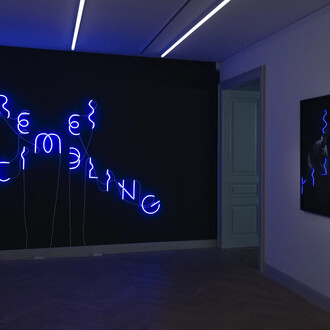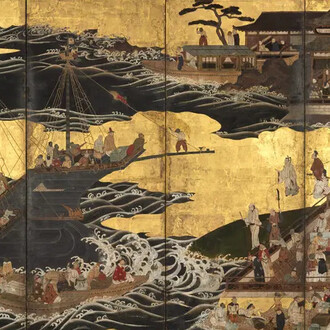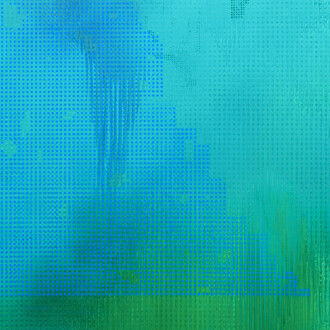Almine Rech is pleased to present Summer, a group exhibition in Gstaad that showcases an eclectic selection of works from esteemed contemporary artists.
The exhibition highlights the unique styles and creative visions of John Giorno, Minjung Kim, Dr. Esther Mahlangu, Larry Poons, Ryan Schneider, Vivian Springford, Kim Tschang-Yeul, De Wain Valentine, Francesco Vezzoli, and Tom Wesselmann.
This exhibition showcases a diverse array of artistic expressions, from the poetic visual language of John Giorno’s text-based works to the vibrant, pop-infused pieces of Alex Israel.
Minjung Kim’s delicate ink paintings complement the bold, abstract forms of Larry Poons and Vivian Springford.
Dr. Esther Mahlangu brings her celebrated Ndebele motifs, while Kim Tschang-Yeul’s water drop paintings offer a serene counterpoint.
De Wain Valentine’s minimalist sculptures and Tom Wesselmann’s iconic American imagery round out the collection. Together, these artists create a dynamic dialogue, reflecting the multifaceted essence of contemporary art.
John Giorno was born on December 4, 1936, in New York City.
After earning a BA from Columbia University in 1958, Giorno established himself as an active presence in New York’s art scene, lauded for his starring role in Andy Warhol’s five-hour film Sleep (1963). A life-long collaborator, he staged multimedia events with Robert Rauschenberg, developed new recording techniques with Bob Moog, and performed alongside William Burroughs and Brion Gysin. In 1967, he published his first monograph, Poems, and his first LP, collaborating with Rauschenberg and Les Levine on the artwork and designs for both.
Giorno created Dial-a-poem at The Architectural League of New York in 1968, which was subsequently included in the landmark group exhibition Information at the Museum of Modern Art in 1970. Dial-a-poem was both celebrated and censored for its selection of readings and speeches by poets and activists. Giorno was unwaveringly unapologetic in his use of politically-charged and sexually salacious content, using his work as a platform to draw attention to his own status as a gay man, to police violence in America, and to the harrowing statistics associated with the war in Vietnam.
In 1971, Giorno visited India and Nepal with Allen Ginsberg, where he gave the Dalai Lama a copy of his book ]Balling Buddha* and met his teacher, His Holiness Dudjom Rinpoche. A Buddhist strain began to form in Giorno’s work, and, in the 1980s, Giorno’s lofts at 222 Bowery became a space for communal practice in his adopted lineage of Nyingma Buddhism.
An artist of self-described “promiscuous compassion,” Giorno has always worked just as much to elevate the work of others as he has on his own. In 1965, he created an organization he called Giorno Poetry Systems, which was initially a pseudonym for his own political organizing and the creation of artworks. In 1972, he launched GPS Records, releasing over forty LPs, cassettes, videopaks and CDs featuring a wide range of new wave, no wave, punk, and other artists, musicians, and poets. In 1974, GPS officially became a 501(c)3 non-profit organization, with a mission to support artists, poets, and musicians.
In 1984, GPS established the AIDS Treatment Project as an emergency response to the impacts of the epidemic on artists’ lives provided funding for artists living with AIDS through the early 2000s.
Giorno was not just a poet but an artist and a performer. In 1969, recognizing that the written word could be powerfully transformed into spoken word, he began a performance practice that he pursued throughout his life, pioneering a distinct and unique style. In 1981, he formed The John Giorno Band and performed at various punk rock venues.
In 1989, he made his first Poem paintings, using a font designed for him by Mark Michaelson. Phrases taken from his poems, combining his interest in Buddhist spiritual texts with his Pop sensibility, were silk-screened on canvas. He continued and expanded his painting practice for the next thirty years.
Giorno met the Swiss artist Ugo Rondinone in 1998, beginning a relationship that lasted the rest of his life, and married in 2017. During the late 2000’s and early 2010’s, Giorno collaborated with a younger generation of artists, including Pierre Huyghe, Michael Stipe, and Rirkrit Tiravanija. A major retrospective of Giorno’s work, I ♥ John Giorno, was curated by Rondinone for Palais de Tokyo in 2015, and was re-imagined for 13 spaces in New York City in 2017, and a website (www.ilovejohngiorno.nyc).
Giorno retired from performing in 2017 and spent the last two years of his life in meditation, artmaking, writing poetry, and working on his memoir, Great demon kings. His iconic poem prints, paintings, prints and drawings continue to show in museums and galleries around the world.
Giorno died in his home at 222 Bowery in 2019.
In 2020, his non-profit began operating under the name The John Giorno Foundation, but in honor of Giorno's legacy and building on GPS's long history of extraordinary events, LPs, and grants, it returned to its original name in 2023 and currently operates as Giorno poetry systems.
Born in Gwangju, South Korea, in 1962, Minjung Kim studied calligraphy and watercolor painting from an early age and went on to major in oriental painting as an undergraduate and graduate student at Hongik University in Seoul. She then studied abroad at Milan’s Accademia di Belle Arti di Brera. During her studies in Europe, she was deeply inspired by artists like Constantin Brâncusi, Carl Andre, and Brice Marden.
Over the past two decades, she has presented her works in Italy, Switzerland, China, the UK, the US, and Mexico, among other countries. She has been the subject of solo exhibitions at renowned galleries and museums around the world, including Macro (Museo d’Arte Contemporanea Roma), Rome (2012); Hermès foundation, Singapore (2017); White cube, London (2018); Langen foundation, Neuss (2019); and Hill art foundation, New York (2020).
She introduced her works in Korea in the exhibition Traces (2015) at OCI Museum of Art, Seoul; her solo exhibition Paper, ink and fire: after the process (2017) at Gallery Hyundai, Seoul; and the international invitational exhibition Making the void, filling the void (2018) at Gwangju Museum of Art, Gwangju.
Kim's presentation at The light, the shade, the depth at Palazzo Caboto in Venice, curated by Jean-Christophe Ammann, received particularly enthusiastic international reviews. Kim participated in the Gwangju Biennale in 2004 and 2018.
Her works are included in the collections of major institutions such as The Leeum Samsung Museum, Seoul, South Korea, Herbert F. Johnson Museum of Art, Cornell University, Ithaca, USA, Princeton University Art Museum, New Jersey, USA, the British Museum in London, UK; RISD Museum, The MET, NY, the Tate Modern, London, among others.
She is currently based in France and the US.
Dr Esther Mahlangu is globally acclaimed for her bright and bold abstract paintings with vivid, geometric patterns that are rooted in Ndebele artistic tradition, a South African community. She was a disruptor from an early age, becoming the first person to reimagine Ndebele visual artistic tradition, historically used for decorating houses, on painting media like canvas.
Dr Mahlangu has spent more than seven decades practicing her technique and has traveled extensively to collaborate with the world's most respected museums, galleries, curators, art fairs, celebrities, and global brands. These high-profile collaborations have generated much positive critic and other exposure and Dr. Mahlangu has developed an almost pop icon status of her own with a strong following among the celebrity crowd who have acquired her work for their collections (Oprah Winfrey, Usher, John Legend, Trevor Noah, David Bowie and Oman, Swizz Beatz and Alicia Keys, Black Coffee, and others).
Although part of a cultural tradition, Esther Mahlangu has radically changed the media and techniques used. In addition to using industrial pigments and colors, the artist has applied these lines and geometric patterns to new surfaces, including sculptures, ceramics, automobiles, and even airplanes. In 1991 she became the first woman and first African to participate in the BMW Art Car Collection alongside other prominent figures such as Andy Warhol, David Hockney, Roy Lichtenstein, and Frank Stella.
Larry Poons has been at the forefront of Abstract American painting since the beginning of his career in the 1960s. Having moved to New York in 1959, Poons became known for his Op-art paintings in 1962, with his monochrome spatial and chromatic experiments. In 1967, Poons abandoned these structural paintings and began a new epoch of ‘drip paintings’, in which lozenges of paint in varying colours are poured from above onto a vertical canvas, creating monumental and energetically charged and textured paintings, recalling the work of Willem de Kooning and Jackson Pollock. Larry Poons was born in 1937 in Tokyo, Japan and currently lives and works in New York City.
Ryan Schneider was born in Indianapolis, IN and holds a BFA from The Maryland Institute College of Art. His work is held in public and private collections worldwide, including the Palm Springs Museum of Art, the Xiao Museum of Contemporary Art, The Hall Art Foundation, Marquez Family Collection, and the Capital One Collection. Among other publications, his work has been reviewed or featured in Frieze, The New Yorker, Art in America, The Brooklyn rail, Juxtapoz, ArtForum, and The Paris review. His first European solo institutional exhibition will occur at Les Musées de la Citadelle in Villefranche-Sur-Mer, France, in 2025. Schneider lives and works in Joshua Tree, CA.
The American abstract painter Vivian Springford (1913-2003) provides a fascinating case study of a mid-century American woman artist. Working first in an Abstract Expressionist and then in a Color Field vocabulary, she was active in multiple facets of the New York art world from the 1950s to 1970s, during which time she had solo and group exhibitions with the Great Jones Gallery, the Preston Gallery, Women in the Arts, and the Visual Arts Coalition.
With an emphasis on gesture, dripping, and splattering, Springford’s works of the 1950s bore a clear connection to Abstract Expressionism. The primary influence of her early work came from East Asian arts and letters, particularly Chinese calligraphy, Taoism and Confucianism. She credited the Chinese-American painter Walasse Ting, whom she met in the mid-1950s, with introducing her to Asian culture. Part of what attracted her about calligraphy as a technique was the fact that it cannot be altered once a mark is made. Her use of this technique resulted in “one-shot” paintings: virtuosic works made in a single go, without alteration or revision.
By 1970 Springford had developed a manner of stain painting that was distinctively her own. Her use of thinned paint on raw or thinly-primed canvas, which she developed with her calligraphic paintings of the late 1950s, developed into more abstract and wash-like marks, with stained colored lines expanding into floods of color. This stylistic approach aligns with the Color Field painters’ exploration of stain painting as a primary mode of mark-making.
Springford once remarked that, for her, the act of painting was an “attempt to identify with the universal whole…. I want to find my own small plot or pattern of energy that will express the inner me in terms of rhythmic movement and color. The expansive center of the universe, of the stars, and of nature is my constant challenge in abstract terms.”1 With her technical inventiveness, formal originality, and seductive use of color, her work deserves a place in the annals of postwar American art, particularly in relation to the histories of Abstract Expressionist and Color Field painting. Following her inclusion in the Denver Art Museum's exhibition catalogue, Women of abstract expressionism (Joan Marter 2016), the time is right for a critical revision and appreciation of Springford’s abundant talent and tireless persistence—a story that mirrors those of so many women artists, past and present.
Kim Tschang-Yeul is one of the greatest Korean painters. Born in 1929 in the north of the then unified Korea, he migrated to the south to escape the communist regime. He subsequently left for New York to pursue his artistic dreams before finally settling in Paris in 1969. There, he began to nurture, over a period of forty years, a unique motif: the drop of water. The waterdrop was the starting point for a singular and iconic body of work, which stands at the confluence of lyrical abstraction, Pop art and Chinese calligraphy. This simple and limpid œuvre subtly fuses Taoist wisdom, modern conceptual irony and the tragedy of war.
Kim Tschang-Yeul is considered one of the pre-eminent figures in the establishment of contemporary Korean art on the international scene, alongside Nam-June Paik and Lee Ufan. His work has been shown around the world for more than fifty years, recently culminating in several important retrospectives at the Gwangju Museum of Art, Korea, 2014; Taiwan National Museum of Fine Art, Taichung, 2012; Busan Museum of Art, Korea, 2009; National Art Museum of China, Beijing, 2006; and Jeu de Paume National Gallery, Paris, 2004.
The public initiative-based Kim Tschang-Yeul Museum, created in honor of the artist, opened on the island of Jeju, South Korea, in 2016.
De Wain Valentine was born in Colorado and arrived in L.A. in 1965 to teach a course in plastics technology at the University of California, Los Angeles (UCLA). He is regarded today among the earliest pioneers in the use of industrial plastics and resins to execute monumental sculptures that reflect the light and engage the surrounding space through its mesmerizingly translucent surfaces that arrest one's gaze. […] This technical knowledge, combined with his subsequent experience working with fiberglass-reinforced plastic in boat building shops and painting automobiles, air planes - and even, according to some, UFOs - led to his fascination and artistic involvement with sculptures made out of colored plastic and polyester resin, all materials evoking a futurist era.
(Extract from an essay by art historian and author Joachim Pissarro, part of the illustrated catalogue on De Wain Valentine published in 2017 by Almine Rech Editions).
Francesco Vezzoli was born in 1971, in Brescia, Italy. He studied at the Central St. Martin’s School of Art in London.
One of the most successful Italian artists in the world, his work can be described as a series of strong allegories about contemporary culture with a rich subtext of elaborate references involving video installations, petit-point embroideries, photography, live performances, media experiments and -most recently- classical sculpture.
His works have been selected four times at the Venice Biennale: at the 49th, 51st and 52nd art editions held in 2001, 2005 and 2007, respectively, and at the 2014 Architecture Biennial. His works have also been featured in other international exhibitions such as the Whitney Biennial 2006, the 26th Biennale in Sao Paulo, the 6th International Biennale in Istanbul and Performa (2007 and 2015).
He has also held solo shows around the world in venues such as the New Museum of Contemporary Art, New York; Tate Modern, London; MOCA, Los Angeles; MOMA PS1 in New York; MAXXI, Museo Nazionale delle Arti del XXI sec, Rome; Moderna Museet, Stockholm; Kunsthalle, Wien; Pinakothek der Moderne, Munich; Museum Ludwig, Cologne; The Garage CCC, Moscow; The Power Plant, Toronto; Jeu de Paume, Paris; Castello di Rivoli Museo d’Arte Contemporanea, Turin; Museo Serralves, Porto; Fondazione Prada, Milan; Le Consortium, Dijon; Fondazione Museion in Bolzano and NMNM- Nouveau Musée National de Monaco.
His work has been shown, among others, at: the Solomon R. Guggenheim Museum in New York, the Metropolitan Museum of Art in New York, the Whitechapel Art Gallery in London, le Grand Palais in Paris, Museo del Novecento in Milan, Palazzo Grassi - François Pinault Foundation in Venice, Fabric Workshop and Museum in Philadelphia, Witte de With Center for Contemporary Art in Rotterdam, the Migros Museum in Zurich, Neues Museum in Weimer, Pirelli Hangar Bicocca in Milan and Musée National Picasso in Paris.
Most recently he produced a special performance for the 40th anniversary of Centre Pompidou and curated an exhibition about Joris-Karl Huysmans at Musée d’Orsay in Paris.
Tom Wesselmann was born in Cincinnati, Ohio, on February 23, 1931. He attended Hiram College in Ohio from 1949 to 1951 before entering the University of Cincinnati. In 1953, his studies were interrupted by a two-year enlistment in the army, during which time he began drawing cartoons. He returned to the university in 1954 and received a bachelor’s degree in psychology in 1956. During this time, he decided to pursue a career in cartooning and so enrolled at the Art Academy of Cincinnati. After graduation he moved to New York City, where he was accepted into the Cooper Union and where his focus shifted dramatically to fine art. He received his diploma in 1959.
Tom Wesselmann emerged as a pivotal figure in the American Pop Art movement of the 1960s, setting aside abstract expressionism to embrace classical representations. His art, particularly in nudes, still lifes, and landscapes, carved out a unique niche with its integration of collage elements and assemblages.
These works often included everyday objects and advertising materials, reflecting his ambition to create imagery as impactful as the abstract expressionism he revered. Wesselmann is renowned for his 'American Nude' series, marked by sensuous forms and vibrant colors. His Standing still life series of the 1970s, featuring free-standing shaped canvases, magnified intimate objects to an impressive scale, showcasing his innovative approach to art.
In the latter part of his career, Wesselmann, under the pseudonym Slim Stealingworth, penned an autobiography detailing his artistic evolution. He continued to experiment with shaped canvases and ventured into metal works, pioneering a laser-cutting technique that allowed precise translation of his drawings into metal forms. This period saw the creation of abstract three-dimensional images, culminating in his 'Sunset Nudes' series. These oil paintings on canvas, with their bold compositions and abstract imagery, paid homage to the odalisques of Henri Matisse.
Wesselmann's work was shown in numerous institutional exhibitions, including retrospectives at institutions like the Museum of Modern Art in New York and the Centre Pompidou in Paris, affirming his status as a significant figure in contemporary art.












